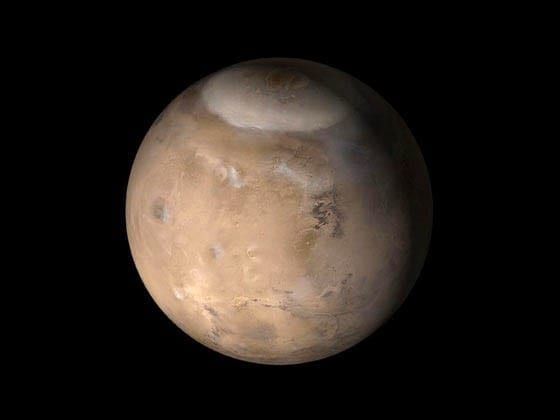 Without water, no form of life as we know it could exist. There is therefore great interest in detecting liquid water on other planets of our Solar System. Landforms such as dry river valleys and lakes show that liquid water must have been present on Mars in the past (1). Nowadays, small amounts of gaseous water exist in the martian atmosphere, and some water ice is found on the planet’s surface. Water droplets were seen condensing onto the Phoenix lander (2), and there may be reoccurring water activity on slopes during the martian summer (3). However, stable bodies of liquid water have not been found on Mars. Published in Science’s First Release this week, Orosei et al. (4) report an analysis of radar data from the Mars Express mission that shows the existence of stable liquid water below 1.5 km of ice, close to the martian south pole.
Without water, no form of life as we know it could exist. There is therefore great interest in detecting liquid water on other planets of our Solar System. Landforms such as dry river valleys and lakes show that liquid water must have been present on Mars in the past (1). Nowadays, small amounts of gaseous water exist in the martian atmosphere, and some water ice is found on the planet’s surface. Water droplets were seen condensing onto the Phoenix lander (2), and there may be reoccurring water activity on slopes during the martian summer (3). However, stable bodies of liquid water have not been found on Mars. Published in Science’s First Release this week, Orosei et al. (4) report an analysis of radar data from the Mars Express mission that shows the existence of stable liquid water below 1.5 km of ice, close to the martian south pole.
Ice caps similar to those on Earth exist at the martian north and south poles, known as the North and South Polar Layered Deposits (NPLD and SPLD, respectively). More than 30 years ago, Clifford hypothesized that liquid water might be present below the martian polar ice caps (5). Despite mean annual air temperatures of around ?60°C, lakes exist below Earth’s Antarctic ice sheet (6). Glacier ice insulates the bed from the cold surface. Thus, temperatures at the base of the Antarctic ice sheet, which may be as thick as 4.8 km, can reach the pressure melting point of water; the melting point is reduced owing to the pressure of the ice layer above. Water at the ice base reduces basal friction, leading to increased flow speeds. Finding liquid water below the martian ice caps might solve ongoing debates about whether the NPLD ice flow is due to ice deformation, deformation of the bed, or gliding over the bed or whether it is not flowing at all (7).
Water below the Antarctic ice sheet has been detected and analyzed by using radar waves that are transmitted actively above the surface. As the electromagnetic radar waves pass downward through the ice, they are reflected back at the interfaces between different materials, such as contacts between ice and bedrock, sediment, or liquid water (see the figure). Along a flight track, measurements are continuously carried out to form an image of the subsurface. Such a radargram shows reflectors from the surface and the base and often multiple weaker reflections from within the ice body. The radar wave reflection is stronger from a water interface than from a rock or sediment interface and therefore shows up as a relatively bright reflector in the radargram.
Orosei et al. now apply this method to data from Mars. The Mars Advanced Radar for Subsurface and Ionosphere Sounding (MARSIS) instrument on the Mars Express spacecraft collected radar measurements over the SPLD. Orosei et al. identify a distinct 20-km-wide bright reflector on multiple profiles collected over 3 years. They rule out a number of possible explanations for this bright reflector, leaving the existence of liquid water, either as a distinct water layer or as saturated sediments, as the only explanation.
It is even colder on Mars than in Antarctica. Temperatures at the base of the SPLD are estimated to be around ?68°C (7), and thus, pure liquid water could not exist there under 1.5 km of ice. However, liquid water may still exist because the freezing point of water is far lower if large amounts of salts are dissolved in the water. Such brine lakes have been found on Earth, with salinities of up to 200 practical salinity units (psu) in the McMurdo Dry Valleys, Antarctica (8). There, water remains liquid down to temperatures of ?13°C. For comparison, ocean water has a salinity between 32 and 37 psu and freezes at about ?2°C.
Salts of sodium, magnesium, and calcium have been found on the martian surface and can reduce the melting point of water to ?74°C (7, 9); when in contact with ice, the salts can suppress the freezing point enough for liquid water to form (7, 10). The droplets observed on the Phoenix lander and the observed reoccurring water activity on slopes were explained by the presence of such briny water (5, 10). Briny water can also explain Orosei et al.’s observation of a stable water body below the SPLD.
In the future, with higher-resolution data, smaller liquid water bodies that influence the ice flow might be detectable below martian ice caps. Like Earth’s ice sheets, the martian ice caps are important climate archives. Depending on the climate, the ice caps grow and shrink as a result of depositional and erosional events. This creates a unique stratigraphy within the ice caps, consisting of layers of equal age that scientists can analyze to derive information about past climate. Changes in ice flow owing to water at the base can change the appearance of these englacial layers; this needs to be considered when reconstructing their age. Analyzing these englacial reflectors, taking the new findings of liquid water below the SPLD into account, can therefore help unravel the climate history of Mars.
Learn more: Liquid water on Mars
The Latest on: Water on Mars
[google_news title=”” keyword=”water on Mars” num_posts=”10″ blurb_length=”0″ show_thumb=”left”]
via Google News
The Latest on: Water on Mars
- Curiosity Detects 'Habitable' Earth-Like Past on Mars, But How Did Oxygen Get There?on May 1, 2024 at 10:22 pm
Rocks scrutinized by the Curiosity rover in an ancient, long-dried lakebed on Mars have revealed conditions likely to have been habitable, billions of years ago. There, in rocks on the Gale Crater, ...
- More evidence that ancient Mars was Earth-like and habitableon May 1, 2024 at 1:58 pm
The results suggest that the sediments were formed in a river, delta, or near the shoreline of an ancient, habitable lake on ancient Mars.
- NASA prepares for intense sun storms on Mars during 'solar maximum'on May 1, 2024 at 12:00 pm
As the sun reaches solar maximum, Mars spacecraft are preparing to study the effects of increased radiation bombardment and how solar storms may impact future crewed missions to the Red Planet.
- Scientists explore how to improve crop yields - on Marson May 1, 2024 at 11:05 am
For future human bases or colonies on Mars to be self-sustaining, a reliable source of home-grown food will be a must. It simply would be too costly and risky to rely upon rocket deliveries to meet ...
- Future farms on Mars could get a boost from intercroppingon May 1, 2024 at 11:00 am
Mars’ atmosphere is about 100 times thinner than Earth’s ... Bits of organic Earth soil and other nutrients was also added to the sand and Martian regolith samples to improve water retention and root ...
- Ancient farm practice could help sustain future humans on Marson May 1, 2024 at 11:00 am
Mars’ atmosphere is about 100 times thinner than Earth’s ... Bits of organic Earth soil and other nutrients was also added to the sand and Martian regolith samples to improve water retention and root ...
- Earth-like environment likely on ancient Marson May 1, 2024 at 10:35 am
A research team using the ChemCam instrument onboard NASA's Curiosity rover discovered higher-than-usual amounts of manganese in lakebed rocks within Gale Crater on Mars, which indicates that the ...
- NASA on Alert: Scientists Gear Up for Solar Storms at Marson May 1, 2024 at 5:35 am
The Sun will be at peak activity this year, providing a rare opportunity to study how solar storms and radiation could affect future astronauts on the Red Planet. In the months ahead, two of NASA’s Ma ...
- Mars missions prepare for intense solar storms on the Red Planeton April 30, 2024 at 5:22 pm
Scientists are gearing up to study how solar storms could impact future space exploration, particularly on Mars.
via Bing News











